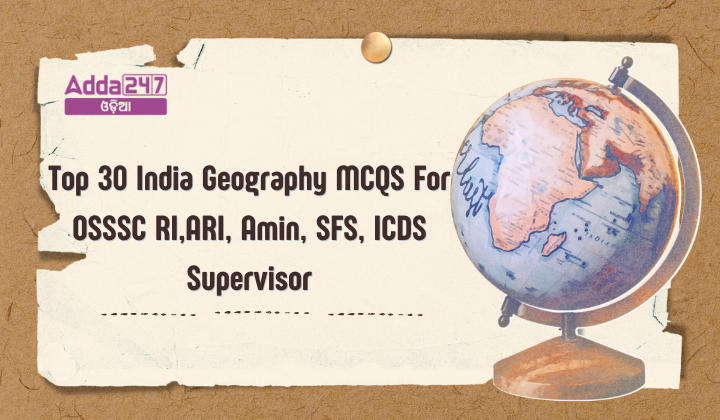Geography plays a crucial role in various competitive exams, including OSSSC RI, ARI, AMIN, SFS, and ICDS Supervisor. To assist candidates in their preparation, we have compiled a set of 30 Multiple Choice Questions (MCQs) at a moderate difficulty level. Each question is accompanied by a correct answer to enhance your geographical knowledge and better prepare you for the upcoming exams.
Top 30 India Geography MCQs For OSSSC RI,ARI, Amin, SFS, ICDS Supervisor
- What is the primary composition of the continental crust?
(a) Silica and magnesium
(b) Silica and alumina
(c) Nickel and iron
(d) Aluminium and magnesium
Ans: (b) Silica and alumina - The oceanic crust is mainly composed of which two elements?
(a) Silica and alumina
(b) Nickel and iron
(c) Silica and magnesium
(d) Iron and magnesium
Ans: (c) Silica and magnesium - How deep does the Earth’s mantle extend?
(a) 1000 km
(b) 2000 km
(c) 2900 km
(d) 3500 km
Ans: (c) 2900 km - Which layer of the Earth is described as having a radius of about 3500 km?
(a) Crust
(b) Mantle
(c) Outer core
(d) Inner core
Ans: (d) Inner core - What are the main minerals that make up the Earth’s crust?
(a) Iron and magnesium
(b) Silica and alumina
(c) Nickel and iron
(d) Calcium and potassium
Ans: (b) Silica and alumina - What term is used to describe rocks formed from the cooling of molten magma?
(a) Sedimentary rocks
(b) Metamorphic rocks
(c) Igneous rocks
(d) Fossil rocks
Ans: (c) Igneous rocks - How are sedimentary rocks formed?
(a) From cooling magma
(b) From heat and pressure
(c) From the deposition of sediments
(d) From mineral crystallization
Ans: (c) From the deposition of sediments - What type of rocks are created when igneous and sedimentary rocks are subjected to heat and pressure?
(a) Sedimentary rocks
(b) Igneous rocks
(c) Metamorphic rocks
(d) Volcanic rocks
Ans: (c) Metamorphic rocks - What is the primary purpose of minerals in human society?
(a) Only for decoration
(b) For medicinal use only
(c) For fuel and industrial applications
(d) Only for geological study
Ans: (c) For fuel and industrial applications - Which minerals are commonly used in the production of fuels?
(a) Gold and uranium
(b) Coal, natural gas, and petroleum
(c) Iron and aluminium
(d) Calcium and phosphorus
Ans: (b) Coal, natural gas, and petroleum - What is the primary role of the Earth’s atmosphere?
(a) To provide oxygen for respiration
(b) To shield Earth from harmful ultraviolet rays
(c) To support plant growth
(d) To regulate the Earth’s temperature
Answer: (b) To shield Earth from harmful ultraviolet rays - How thick is the Earth’s atmosphere approximately?
(a) 320 km
(b) 400 km
(c) 480 km
(d) 600 km
Answer: (c) 480 km - Which gas makes up about 78% of the Earth’s atmosphere?
(a) Oxygen
(b) Argon
(c) Nitrogen
(d) Carbon Dioxide
Answer: (c) Nitrogen - What is the percentage of oxygen in the Earth’s atmosphere?
(a) 21%
(b) 78%
(c) 0.93%
(d) 0.04%
Answer: (a) 21% - Where is the ozone layer located within the Earth’s atmosphere?
(a) Troposphere
(b) Stratosphere
(c) Mesosphere
(d) Thermosphere
Answer: (b) Stratosphere - What phenomenon occurs in the mesosphere?
(a) Weather changes
(b) Absorption of ultraviolet radiation
(c) Burning of meteoroids
(d) Reflection of radio waves
Answer: (c) Burning of meteoroids - At which layer does the temperature start to increase with altitude due to the absorption of UV radiation?
(a) Troposphere
(b) Stratosphere
(c) Mesosphere
(d) Thermosphere
Answer: (b) Stratosphere - What is the main component of the Earth’s atmosphere that is used in light bulbs?
(a) Oxygen
(b) Nitrogen
(c) Argon
(d) Carbon Dioxide
Answer: (c) Argon - In which atmospheric layer do satellites primarily orbit?
(a) Troposphere
(b) Stratosphere
(c) Mesosphere
(d) Thermosphere
Answer: (d) Thermosphere - What is the role of dust particles in the atmosphere?
(a) Absorb UV radiation
(b) Reflect radio waves
(c) Act as hygroscopic nuclei for cloud formation
(d) Regulate atmospheric pressure
Answer: (c) Act as hygroscopic nuclei for cloud formation - What is another name for extra-tropical cyclones?
(a) Tropical storms
(b) Mid-latitude storms
(c) Hurricane systems
(d) Trade wind cyclones
Answer: (b) Mid-latitude storms
Explanation: Extra-tropical cyclones are also known as mid-latitude storms or baroclinic storms. - Where do extra-tropical cyclones typically form?
(a) Near the equator
(b) Along the polar front
(c) In the tropics
(d) At the equatorial low
Answer: (b) Along the polar front
Explanation: Extra-tropical cyclones form along the polar front, which is a boundary between cold polar air and warmer air from the mid-latitudes. - In the Northern Hemisphere, which direction does the cold air move relative to the front?
(a) From the south
(b) From the west
(c) From the north
(d) From the east
Answer: (c) From the north
Explanation: In the Northern Hemisphere, cold air moves from the north of the front, while warm air blows from the south. - What happens when the cold front overtakes the warm front?
(a) The warm front intensifies
(b) The warm air is lifted entirely, leading to an occluded front
(c) The cold front slows down
(d) The cyclone strengthens
Answer: (b) The warm air is lifted entirely, leading to an occluded front
Explanation: When the cold front moves faster than the warm front, it lifts the warm air, leading to the formation of an occluded front and the eventual dissipation of the cyclone. - How do extra-tropical cyclones affect precipitation?
(a) They cause rainfall only ahead of the warm front
(b) They cause rainfall only along the cold front
(c) They cause rainfall both ahead of the warm front and along the cold front
(d) They do not cause rainfall
Answer: (c) They cause rainfall both ahead of the warm front and along the cold front
Explanation: Rainfall occurs ahead of the warm front due to the warm air climbing over the cold air and along the cold front as the warm air is pushed upward. - What type of clouds typically develop along the cold front of an extra-tropical cyclone?
(a) Stratus clouds
(b) Cumulus clouds
(c) Cirrus clouds
(d) Nimbostratus clouds
Answer: (b) Cumulus clouds
Explanation: Cumulus clouds typically develop along the cold front due to the upward movement of warm air. - How long can extra-tropical cyclones last?
(a) 1 to 3 days
(b) 3 to 7 days
(c) 7 to 10 days
(d) 15 to 20 days
Answer: (d) 15 to 20 days
Explanation: Extra-tropical cyclones can last for a duration of 15 to 20 days, unlike tropical cyclones which typically last no more than 7 days. - Which of the following is a key difference between tropical cyclones and extra-tropical cyclones?
(a) Tropical cyclones form only over land
(b) Extra-tropical cyclones have higher wind velocities
(c) Tropical cyclones move from east to west
(d) Extra-tropical cyclones form only in tropical regions
Answer: (c) Tropical cyclones move from east to west
Explanation: Tropical cyclones generally move from east to west, while extra-tropical cyclones move from west to east. - Which cyclone type affects a larger area?
(a) Tropical cyclone
(b) Temperate cyclone
(c) Neither
(d) Both equally
Answer: (b) Temperate cyclone
Explanation: Temperate cyclones, or extra-tropical cyclones, affect a much larger area compared to tropical cyclones. - Where can extra-tropical cyclones form?
(a) Only over seas with temperatures above 26-27°C
(b) Only over land
(c) Both over land and sea
(d) Only in the tropics
Answer: (c) Both over land and sea
Explanation: Extra-tropical cyclones can form over both land and sea, unlike tropical cyclones which form only over seas with warm temperatures.
















